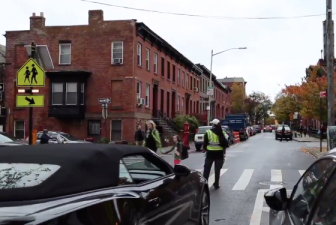To Obey, Or Not to Obey

Not getting flattened by a 50,000 pound "big rig" is a good reason to stop at a red light if you’re on a bicycle. But how about less skin-saving reasons? Are there in fact, good reasons to ignore traffic regulations when you can, because after all, they are really meant just for cars?
It’s a question that comes readily to mind at times, particularly say when pedaling up a steep hill or going down one, and having to stop at a red light in the middle. Many of us often just cruise through with a careful glance in each direction, but we feel guilty about it. Should we?
Maybe not. If you look historically, you’ll find that there were practically no traffic regulations as we know them before cars. No stop signs. No traffic lights. No left turn lanes. In the 19th century, the streets of New York were a seething mass of horse drawn wagons, walking adults, playing children and yes, in the late 19th century, bicyclists.
Cars changed this. In the 1930s, traffic congestion became a serious and unanticipated problem. How to handle it? Enter the new "science" of traffic engineering. With the addition of stop signs, street lights and all the other accoutrements that are common today, traffic congestion would soon be a thing of the past, the new professionals assured the public.
Of course, this wasn’t true at all. What it did do was make that street much less convenient for someone on a bicycle or using any other form of non-motorized travel.
So here’s my point. Given that most traffic controls were put into place solely for the benefit of drivers, why should the rest of us have to obey them? They’re not helping us. In fact, they’re impeding us.
What we may need to move toward is some sort of system where cyclists, non-motorized scooter riders, skaters or users of any other kind of self-propelled vehicle are exempted or partially exempted from traffic controls. It could be understood that a red light is there to control the car or truck, not everyone else.
There are a number of options. What Montreal does on some streets is to let cyclists proceed six seconds before the cars do at some red lights. This frees cyclists from being lost in a swirl of drivers going around them. In many Dutch cities, drivers are bound by one way streets, but not cyclists. Imagine such a thing here.
Most effectively, the state could rule, as most Scandinavians have, that in any collision between a pedestrian, a cyclists or a driver, the largest, heaviest vehicle is at fault. This means that pedestrians take precedence over cyclists, and cyclists take precedence over drivers. This would be a de-facto way of exempting cyclists and pedestrians from most automobile-oriented traffic regulation.
One particular regulatory device we could consider having cyclists relate differently to is one way thoroughfares, which are so ubiquitous in New York City.
One way streets are a fairly recent "innovation," many being put into place in the 1950s and 1960s, and again solely for the supposed benefit of drivers. There were many ill effects, and not just for cyclists. Jane Jacobs commented in her classic 1961 "Death and Life of Great American Cities" that every time New York City converted an avenue to being one way, bus traffic would take a significant drop, because people now often had to walk an avenue over to catch a bus traveling in the right direction.
I may be digressing here, but people give those poor delivery guys hunched over their bicycles so much grief for going the wrong way down one-way streets. But rather than penalize their employers, something currently proposed by the New York City Council, how about getting rid of a lot of the one way streets? Or even exempting cyclists from having to obey one way regulations?
This may sound insane, but the fact is it’s often irresistible to a biker to go the wrong way down a one way street. If I’m at 15th and Eighth Avenue in Manhattan, for example, to get to 14th and Eighth Avenue would require a very long journey if done legally. I would have to cycle down 15th to Ninth Avenue, and then up 14th Street back to Eighth Avenue. That’s almost a half mile, given how long Manhattan blocks are. Or, I could travel illegally a 100 feet or so down Eighth Avenue. You can understand why a delivery person, or I, for example, would be so tempted.
There’s a school of cycling called "vehicular" or "integrated" cycling that advocates that cyclists in essence act like motorists. That is, they should take up a whole lane of traffic, and obey all traffic regulations. While this may make sense tactically at times, for example to avoid getting squeezed out by city bus, it’s a stupid philosophy. A bicycle is not a car, much less a truck. It’s a very different device, and it needs a different set of regulations, one that can be looser and more permissive, given its less substantive nature.
Photo: hen power/Flickr
